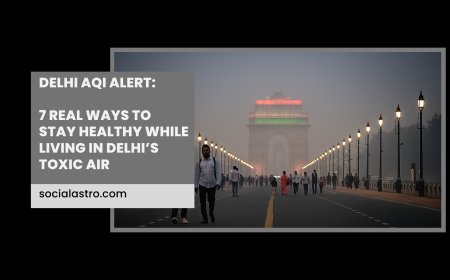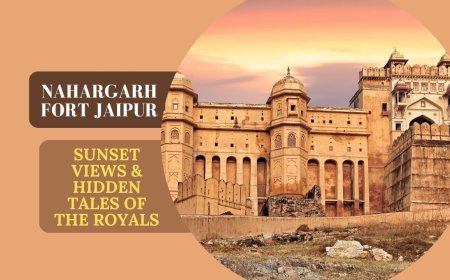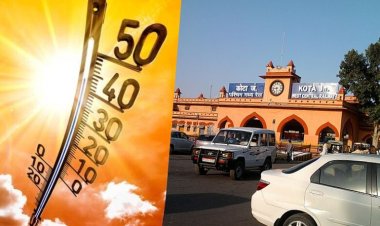Global Warming in India: Rajasthan Heatwave Hits 50°C
Rajasthan’s record-breaking heatwave after 27 years highlights the growing impact of global warming in India. Discover what’s causing these extreme temperatures and why urgent climate action is needed.

Imagine walking outside and instantly feeling like you’re being baked alive. That’s exactly what people in Rajasthan have been dealing with recently. This April, the state recorded its highest temperature in Rajasthan in 27 years—and it's not just a fluke of nature. It's a clear, burning reminder of how global warming and climate change in India are accelerating faster than we can handle.
Rajasthan’s Heat Wave: A New Record, But Not in a Good Way
In parts of Rajasthan like Barmer and Phalodi, temperatures soared past the 50°C mark, setting off alarms not just in weather stations, but in hospitals and homes too. People fell ill, schools shut down early, and water demand spiked in already dry regions.
Rajasthan isn’t a stranger to heat—it’s home to the Thar Desert, India’s largest. But this kind of extreme, early-season heat? It’s different. It’s more intense, more dangerous, and it lasts longer than anything we’ve seen in decades.
This Isn’t Just Weather—it’s Climate Change in Action
You might be wondering, "Isn’t this just a particularly hot summer?" Not quite. What we’re seeing is part of a larger, alarming trend. Global warming in India, driven by human activities like burning fossil fuels, deforestation, and unplanned urbanization, is trapping more heat in our atmosphere.
Think of Earth as a greenhouse. The sun's rays come in, but thanks to greenhouse gases like CO₂ and methane, that heat gets stuck. And each year, that extra heat builds—raising average temperatures, increasing the frequency of heatwaves, and changing weather patterns across the subcontinent.
Global Warming and Climate Change in India: A Growing Threat
India’s climate is changing rapidly. It’s not just Rajasthan. All across the country, we’re seeing the damaging effects of climate change and global warming in India:
-
Unpredictable monsoons that flood some regions and parch others.
-
Melting Himalayan glaciers, threatening water supplies and increasing natural disasters.
-
Rising sea levels, already encroaching on our coastlines.
Here’s a startling fact: By the end of this century, sea levels could rise by at least a foot compared to 2000. That puts cities like Mumbai, Chennai, and Kolkata at serious risk of flooding and coastal erosion.
Why This Heatwave Matters More Than Ever
It’s easy to dismiss a heatwave as just another hot summer. But this is different. The highest temperature in Rajasthan is more than just a number—it’s a warning. Here’s how extreme heat linked to global warming is impacting lives in India:
-
Health risks: Heatstroke, dehydration, and fatigue—especially for children, the elderly, and outdoor workers.
-
The strain on infrastructure: More electricity for cooling, more water demand, and frequent blackouts.
-
Damage to agriculture: Crops wither before harvest, threatening food security and farmer incomes.
-
Water scarcity: Especially in arid regions like Rajasthan, where water stress is now a constant worry.
If it’s this bad today, imagine what future summers could look like if we fail to take action.
Causes of Global Warming in India
Understanding the root causes is key to creating change. Here are the main causes of global warming in India:
-
Burning of fossil fuels (coal, oil, natural gas) for electricity and transport.
-
Deforestation to make way for roads, industries, and agriculture.
-
Industrial emissions from factories and vehicles.
-
Waste mismanagement, including methane released from landfills.
-
Rapid urbanization increases energy consumption and heat retention.
Measures to Control Global Warming in India
Thankfully, it’s not too late. There are powerful measures to control global warming in India, and many are already being implemented:
-
Switch to renewable energy: Solar, wind, and hydroelectric sources are essential. India’s solar capacity has grown significantly and should be expanded further.
-
Energy efficiency: Promote fuel-efficient vehicles, LED lighting, and sustainable public transport.
-
Reforestation and afforestation: Plant more trees and protect existing forests.
-
Water conservation: Encourage rainwater harvesting, recycling wastewater, and community-led conservation efforts.
-
Urban planning: Build green infrastructure, promote sustainable housing, and increase public green spaces.
These aren’t just policies—they are lifelines for the future of our environment, health, and economy.
A Shared Responsibility
India is already taking steps: we're part of the Paris Climate Agreement, investing in clean energy, and pushing for sustainable development. But there's a long road ahead. Global warming and climate change in India won’t stop on their own. We must act—individually and collectively.
So whether you’re a policymaker or a student, a farmer or a CEO—your actions count. Support green policies, conserve energy and water, and raise awareness in your communities.
Final Thoughts: The Time to Act Is Now
The heatwave in Rajasthan is more than just a scary headline—it's a red flag. Global warming isn’t knocking on India’s door—it’s already inside. And while we can’t turn down the sun, we can cool the planet, slow the damage, and build a future we’re proud to pass on.
Let this be a wake-up call—not just for Rajasthan, not just for India—but for everyone who calls Earth home.
What's Your Reaction?
 Like
0
Like
0
 Dislike
0
Dislike
0
 Love
0
Love
0
 Funny
0
Funny
0
 Angry
0
Angry
0
 Sad
0
Sad
0
 Wow
0
Wow
0
































































































